
When it comes to slasher villains of the ‘80s, Chucky stands alongside Freddy Krueger, Jason Voorhees, and Michael Myers as the most iconic — just several feet below. But while Freddy and his Nightmare on Elm Street franchise, Jason and the Friday the 13th movies, and Michael and the Halloween series have endured countless reboots, revivals, stars, and filmmakers over the past few decades, Chucky has remained under the control of his creator, Don Mancini, who has written every entry in the franchise since cowriting Child’s Play in 1988. He’s also been voiced by the same actor, Brad Dourif — and terrorized many of the same costars — in each installment. That’s not just rare for a slasher series: It’s unprecedented.
The pint-sized redhead doll possessed by the spirit of a serial killer may not have gone to space like Jason Voorhees or tussled with Tyra Banks like Michael Myers, but he has seen some wild shifts over the years. Over the past three decades, the Child’s Play series has transitioned from horror to comedy and back to horror again, and Chucky himself has been the villain, the antihero, and yes, even the romantic lead. That’s because Mancini is as committed to retaining his hold on the series as he is to never doing the same thing twice.
“Any good story is about surprising the viewer and subverting their expectations," Mancini said. "With sequels, you have a unique opportunity to do that because people come to a sequel or remake with very specific expectations. So it’s like, how can I fuck with that?”
The most consistent thing about the seven-film Child’s Play franchise is that it’s constantly reinventing itself — not as a result of studio intervention, but because of Mancini’s drive to keep audiences on their toes. In a genre that has been derided for being repetitive, Chucky stands alone.
BuzzFeed News sat down with Mancini to talk about the series’ humble beginnings, its growing pains, and how to keep a franchise going without losing an audience who has seen it all. From Child’s Play in 1988 to Cult of Chucky, now streaming, this is an inside look at one of horror’s most dynamic icons.

Child's Play (1988): “Hi, I’m Chucky, and I’m your friend till the end.”

In retrospect, the first Child’s Play is almost quaint in its restraint — that is, as restrained as a movie about a killer doll can be. The film follows 6-year-old Andy Barclay (Alex Vincent), who has no idea that the Good Guy doll he’s been gifted for his birthday has been imbued with the spirit of sadistic serial killer Charles Lee Ray (Dourif). As the body count rises, Andy’s mother Karen (Catherine Hicks) and homicide detective Mike Norris (Chris Sarandon) begin to suspect that the young boy is a budding psychopath.
In Mancini’s original script, which he wrote as a film student at UCLA, Andy was inadvertently responsible for the murders: Chucky was actually a manifestation of Andy’s id. Mancini described the film as “a dark satire about how marketing affects children,” inspired by his father’s career in marketing. “I had already formed a pretty cynical perspective on that whole cult,” he said.
But after United Artists, a subsidiary of MGM, picked up the movie, Child's Play underwent some significant changes. Director Tom Holland worked on a new version of the script alongside screenwriter John Lafia, and the focus shifted from the fragile psyche of a child to the (relatively) more straightforward story of a serial killer trying to get out of a tiny plastic body. The new creative team also dropped Chucky’s singsong doll voice in favor of Dourif’s Chicago rasp, and added some supernatural mythology. “I can’t be completely objective about it, because of some of the changes they made,” Mancini said. “I really hate the voodoo. I hate the chant. I hate all of that.”
Despite Mancini's objections, Child’s Play was a major hit, earning over $33 million at the US box office on a $9 million budget. Chucky quickly emerged as a new horror icon, notable for the way he stood out from his slasher villain contemporaries. In his review, Roger Ebert said that the film “succeeded in creating a truly malevolent doll. Chucky is one mean SOB.”
Mancini may have had a slightly different idea for the killer doll when he first wrote the script, but this Chucky matched his goal of designing a character who would surprise audiences. “I was excited about the prospect of creating a horror villain that went in the opposite direction — in terms of just their physical presence — than what was popular at the time, which was Freddy, Jason, and Michael Myers,” he said. “They’re all these big, hulking guys who just sort of relentlessly come after you.”
Chucky was his own beast — his closest relative would be Freddy, who shared his penchant for wisecracking; the others were the strong, silent types. And yet, there was at least one other thing Chucky had in common with the others — despite his apparent death at the end of the first movie, he was instantly poised for a sequel.

Child’s Play 2 (1990): “Wherever I go, Chucky will find me.”
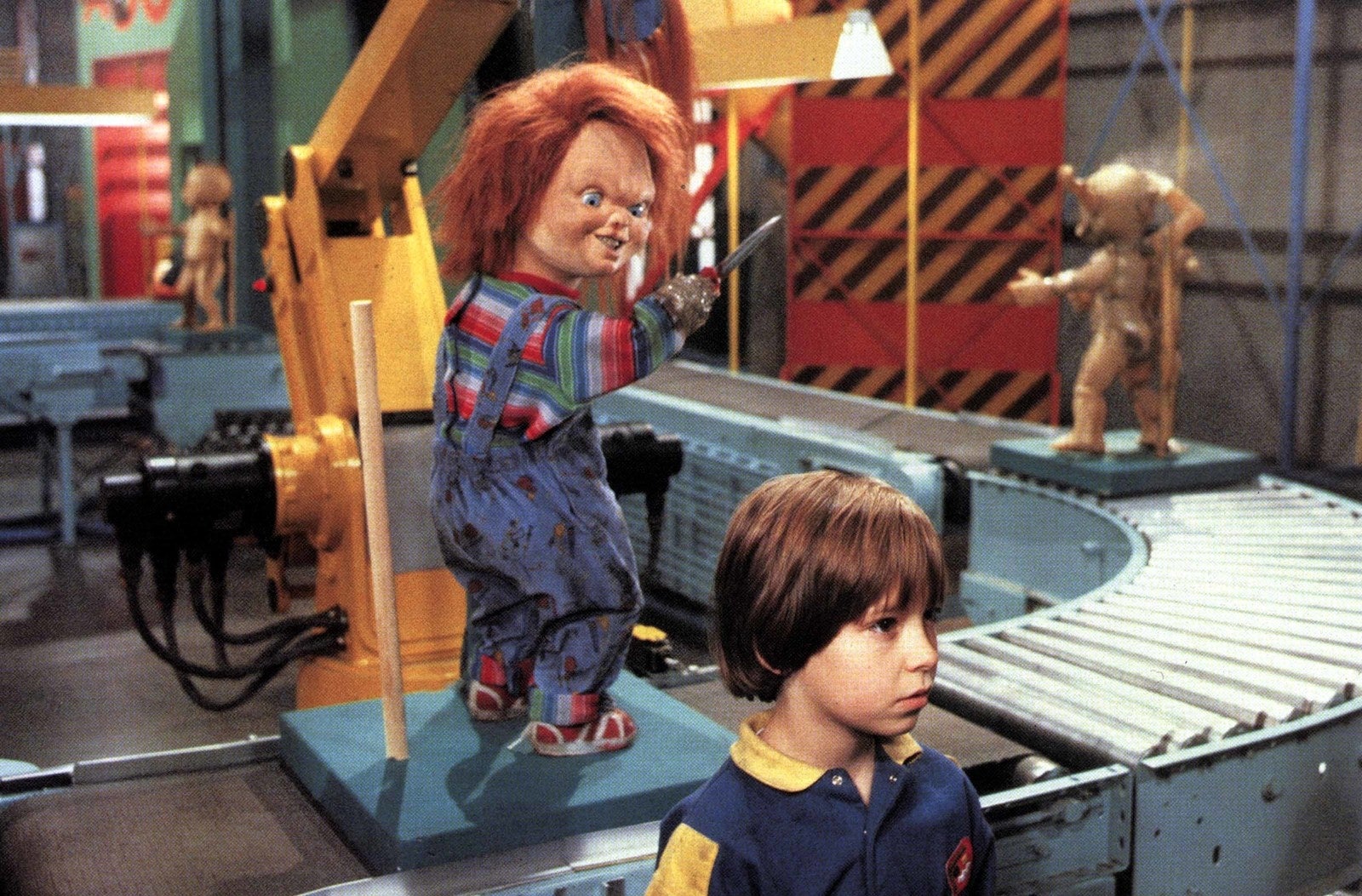
The success of Child’s Play meant that Mancini didn’t have much downtime: He started working on a sequel within a couple weeks of the first movie's debut. “It happened really fast,” he recalled. “The movie was a hit and they wanted to develop a sequel very quickly.”
Mancini didn’t love that he had to follow the mythology added to the first film — in order to return to human form, Chucky can only transfer his soul to Andy, the first person he revealed his true self to — but he admitted that the “contrivance” was “very narratively useful.” And it positioned Andy as the franchise’s final girl, the last survivor in a slasher film and a role usually given to a teenage girl.
Even with the second movie, which was distributed by Universal Pictures, Mancini was already worried about repeating himself. “When you do sequels, it’s always tricky because you … definitely don’t want to do the same movie,” he said. “You have to give people what they want — but at the same time, spin it.”
To avoid simply making Child’s Play again, Mancini ditched the original adult characters, Karen Barclay and Mike Norris. In Child’s Play 2, Vincent returned as Andy Barclay, but he would be living with foster parents Phil (Gerrit Graham) and Joanne Simpson (Jenny Agutter) and a foster sister, Kyle (Christine Elise) — of course, he was still being pursued by the same malevolent doll. Mancini also reintroduced some of the elements that had been removed from his original script for Child’s Play, including a visit to the factory where Good Guy dolls are assembled.
And he continued to lean into the humor that made Chucky a sassier alternative to the muted killers who usually stalked horny teens in slasher movies. “Certainly there was some serious camp,” Dourif said. “It wasn’t a straight horror movie about a doll. Chucky was funny. He took his killings lightly.”
With Child’s Play 2, which grossed $28.5 million in the US on a $13 million budget, Chucky was becoming a sort of hero in his own right. While his victims were never as disposable as those in other slasher series are, Chucky himself was clearly the selling point. As one review noted, “There reaches a point at which one can't help but be drawn into Chucky's predictably murderous shenanigans.”
“Chucky had been embraced by the pop culture zeitgeist to the degree that he was kind of beloved,” Mancini said. “He was already a bit of an antihero, and part of the way he worked was by bucking the status quo.” And that gave Mancini the idea for the next sequel. In hindsight, it wasn’t a great one.

Child’s Play 3 (1991): “Grow up, Barclay. It’s time to forget these fantasies of killer dolls.”
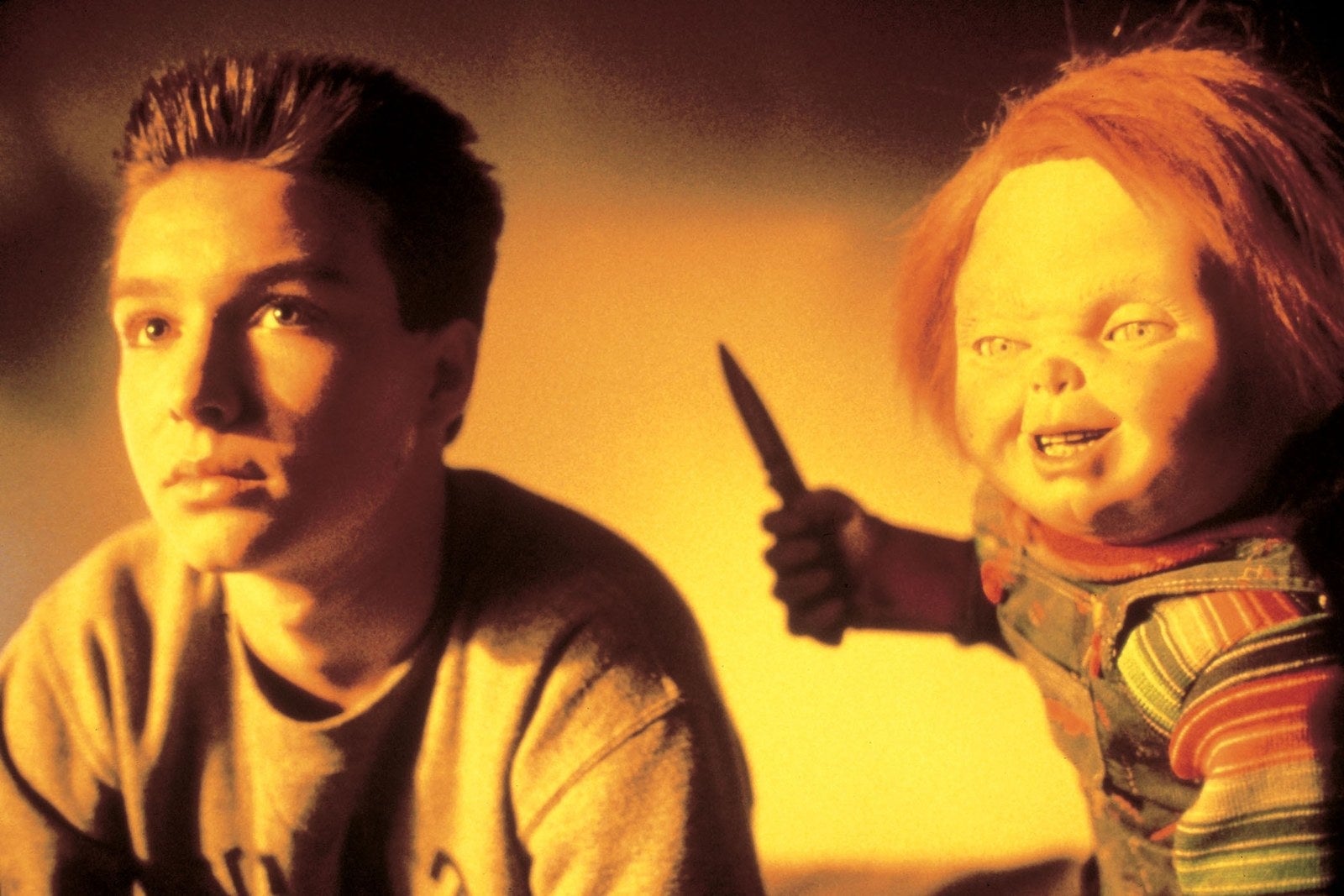
In Child’s Play 3, Chucky is still after Andy, but the troubled kid at the heart of the first two movies has aged up to 16 and the action has relocated to Kent Military Academy, where Andy (now played by actor Justin Whalin) is a cadet. The idea, as Mancini envisioned it, was to pit his antiestablishment killer doll against the conservative, ordered ideology of the military school and its cruel authority figures.
Child's Play 3 came out in August 1991, just nine months after Child’s Play 2, and it failed to resonate with either audiences or critics. The film earned the worst reviews of any in the franchise, with a Rotten Tomatoes score of 23%. Entertainment Weekly gave it an F, with critic Owen Gleiberman writing, “The plastic slasher proves that his novelty value has long worn off.”
Mancini doesn't entirely disagree. He describes Child’s Play 3 as “the weakest of the films, and really it’s all down to the script”: “Despite aging Andy, despite putting it in this new milieu, I think it felt a little tired,” Mancini said. “In retrospect, I think I could have used a breather. But you also get stuck in your own bubble, and [think], This is great. And they just wanted another movie to come out quickly.”
Even if Child’s Play 3 was largely a failure, it underscored Mancini’s willingness to try something new to prevent the series from growing stale. It also reflected a problem that Chucky’s predecessors — namely Freddy Krueger — had faced: Eventually, the killer stops being scary.
“The more you see, the less scary they are,” Mancini said. “And in our case, with Chucky, it’s an even bigger problem — it’s absurd to begin with because he’s so little.” He tried to solve that by keeping Chucky in the shadows for some of Child’s Play 3 and focusing on new characters, but audiences were hungry for more Chucky, not less — particularly after advancements in technology allowed the character to stand on his own. Even the Washington Post's overwhelmingly negative review called Chucky an “animatronic delight.”
The year after Child’s Play 3, Universal made Chucky a permanent installment at their annual Halloween Horror Nights event. Fans would line up for the “Chucky’s In-Your-Face Insults” for a chance at being read for filth by a killer doll.
For the next sequel, Mancini knew he had to put Chucky front and center, and his solution was to move into another genre entirely.

Bride of Chucky (1998): “Barbie, eat your heart out.”
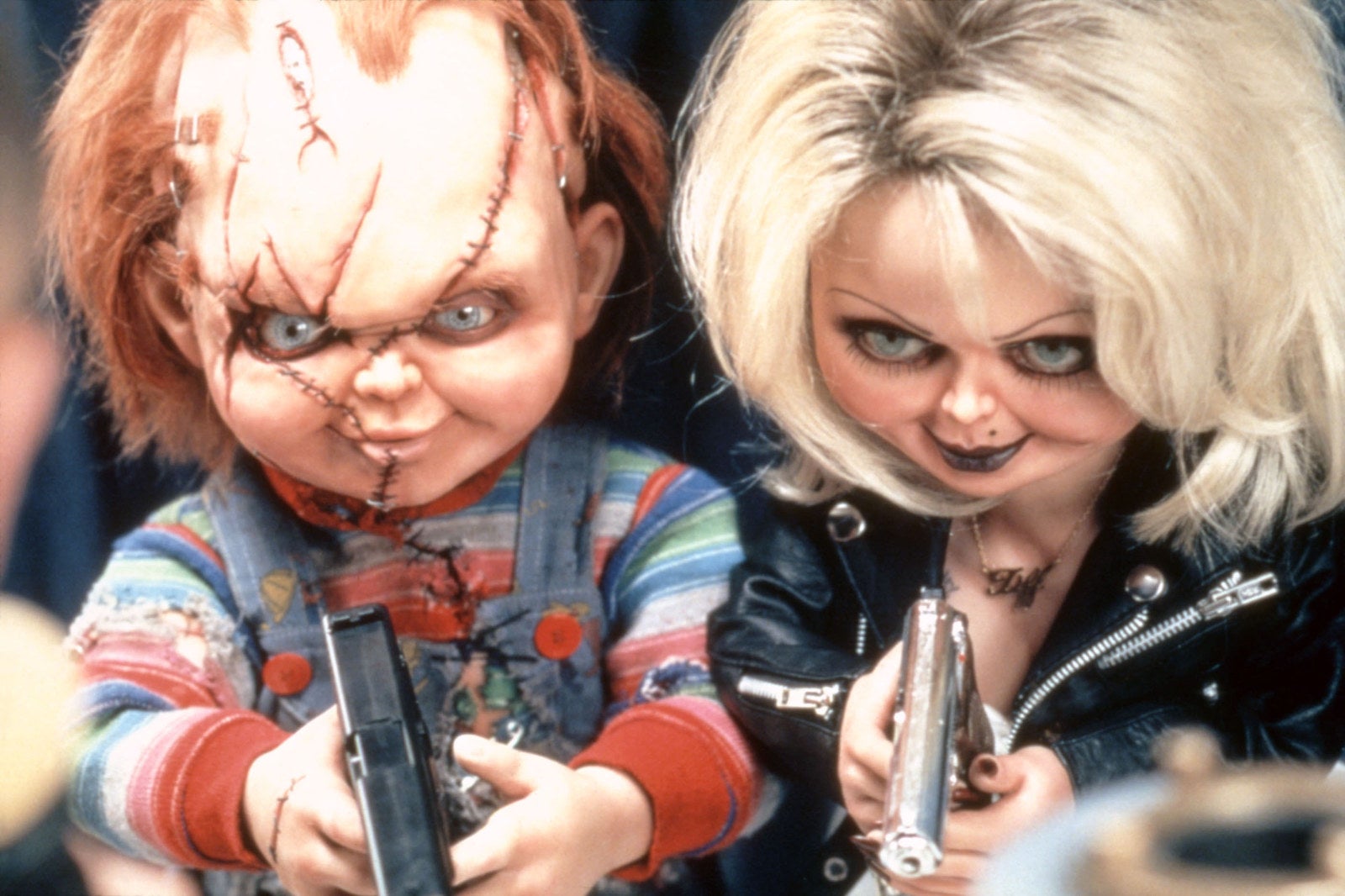
The downside to Chucky’s mainstream appeal was that the villain, once the stuff of nightmares, had clearly become more amusing than menacing to many people. “You just have to find ways of embracing that and subverting it; so obviously when we did Bride of Chucky, we decided to swing out the wave and embrace the absurdity,” Mancini said.
It took seven years before Chucky returned for his fourth movie, Bride of Chucky, which ditched the Child’s Play title and the character of Andy Barclay entirely. Inspired by the classic film Bride of Frankenstein — the title is an obvious homage — the movie sees Charles Lee Ray’s girlfriend Tiffany Valentine (Jennifer Tilly) transformed into a doll of her own. Together, the dolls join forces to possess the bodies of two new victims, Jesse (Nick Stabile) and his girlfriend Jade (Katherine Heigl). Along the way, Chucky and Tiffany bicker, fall in love, and — in a truly surreal moment — get hot and heavy, somehow getting Tiffany pregnant. (The less you think about the logistics, the better.)
Just as Bride of Frankenstein brought a touch of humor to the Universal Monsters series, Bride of Chucky was the funniest installment yet in the Child’s Play franchise. Mancini conceived of the film as a twisted romantic comedy, as much about Chucky and Tiffany’s dysfunctional relationship as it was about their murder spree. “Chucky's a very versatile figure and you can plug him into different genres,” Mancini said. “If we make it a comedy [and] bring him to the center and make him the lead of the movie, you're just making a different kind of movie. But that's a legitimate kind of movie.”
And Bride of Chucky was the biggest departure from the original Child’s Play, but it was very much in step with the era of the new, more meta slasher ushered in by Scream in 1996. In addition to the heightened comedy, Bride of Chucky reinvigorated the franchise by introducing Tiffany, a character Mancini had written specifically for Tilly.
“I was a little bit reluctant because I had never done a horror film before, and I kind of had some weird idea that horror film was something you did at the beginning of your career or the end of your career,” Tilly recalled.
Tilly ended up being convinced by the script — and some encouragement from her former Bound costar Gina Gershon. Tilly's presence as a gay icon, thanks largely to Bound, gave Bride of Chucky a stronger queer sensibility, something Mancini, who is gay, had been angling for. He also introduced (and then killed off) the first gay character in the franchise, Jesse and Nick’s friend David (Gordon Michael Woolvett).
“I was sort of consciously injecting some gay identity into it, and people really embraced that,” Mancini said. “I think it's important — in addition to being fun — because you just don't see it much in the horror genre. … One of the distinguishing factors of our franchise is that it has a certain gay identity.”
Critics were still divided on Bride of Chucky, but the box office was strong: The film grossed over $50 million worldwide on a $25 million budget. Audiences seemed to love it, and the largely positive response to a funnier, queerer Chucky movie delighted Mancini. In fact, he was “so emboldened by it” that he “went insane on Seed of Chucky.”

Seed of Chucky (2004): “This is nuts, and I have a very high tolerance for nuts.”

“I didn’t want to make the same movie as Bride of Chucky, so I thought, make it even crazier, make it meta,” Mancini said. “That was less successful.”
While Seed of Chucky has become something of a cult classic with vocal defenders, it was reviled by most critics and became the last Child’s Play movie to be released in theaters. But to call it crazy? That’s not up for debate. This is a film in which the actor Jennifer Tilly (Tilly, playing herself) is impregnated after Chucky masturbates into a turkey baster. John Waters makes a cameo. Britney Spears is murdered. And the film’s makeup effects artist, Tony Gardner, appears as himself in a scene in which he is decapitated by Chucky and Tiffany.
At its heart, however, Seed of Chucky tells the surprisingly poignant story of Glen (voiced by Billy Boyd), the gender-nonconforming child of Chucky and Tiffany. Glen (who is referred to as male in the film) struggles with his resistance to violence, which he views as an addiction shared by his homicidal parents. He also shares a body with his female persona, Glenda — a reference to Ed Wood’s infamous cross-dressing classic Glen or Glenda. While the film’s treatment of gender identity is muddled, Seed of Chucky is undeniably queer, something that baffled executives at Focus Features, who had acquired the property from Universal.
“The note that came down was, ‘This is too gay,’” Mancini said. He didn’t pull back, although he acknowledges that Seed of Chucky might have been a bit much for the time it was released.
Many fans were equally put off by a movie that took the subtle queer sensibility of Bride of Chucky and cranked it to 11. “There were a lot of the core horror fans who are young, straight guys who were like, ‘What the hell is this?’” Mancini remembered.
But Mancini stands behind Seed of Chucky’s gay identity, which he believes places it in a long-standing tradition of queer horror. Glen, who ultimately gives in to his killer urges, is a point of identification for queer fans who often don’t find themselves represented in the genre. “I think why gay men are drawn to horror is ... that outside identification, with figures ranging from Frankenstein's monster to Carrie,” Mancini said. "You have the lonely, misunderstood monster, or what the world perceives as a monster, but we, the audience, are inside them with their hearts and we know that they're beautiful but misunderstood and corrupted by the evil world.”
And while there are still those eager to tweet at Mancini to tell him why Seed of Chucky was such a disappointment, he’s also heard from countless queer fans who revere the film. A recent review celebrated Seed of Chucky as a “radical queer masterwork.” It’s feedback Mancini relays with particular pride. And not for nothing, Ed Wood was misunderstood in his time, too.

Curse of Chucky (2013): “25 years, must be the slowest murder in history.”
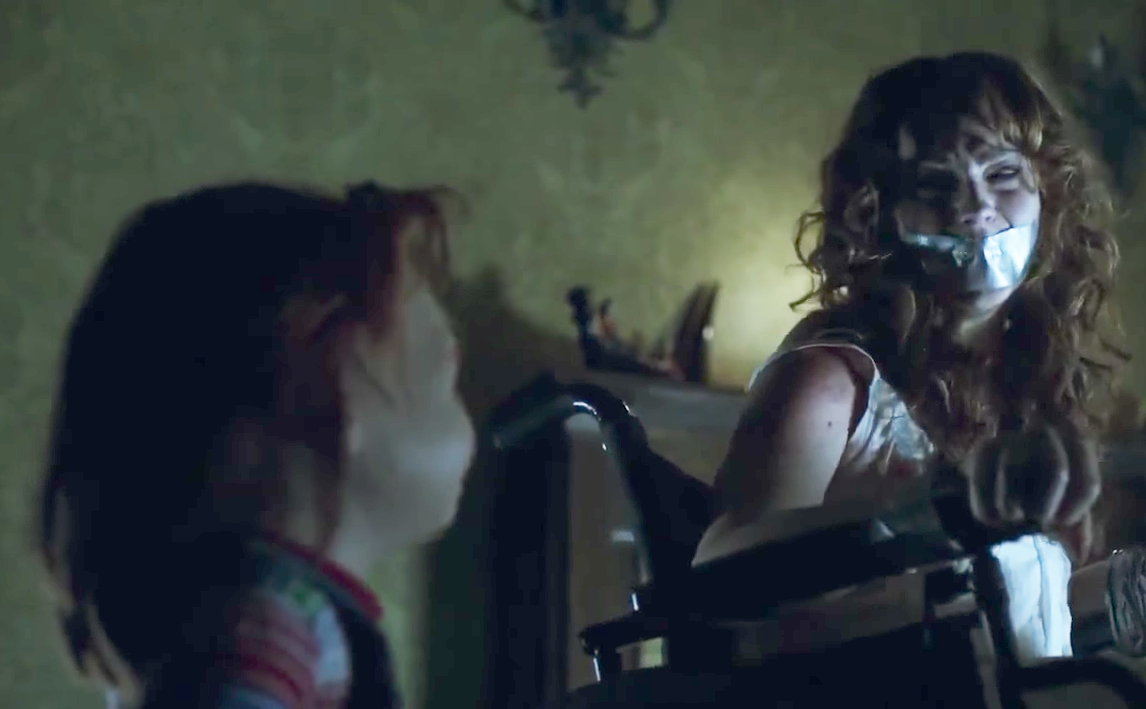
But where do you go after the unabashed lunacy of Seed of Chucky? For Mancini, the answer was back to the beginning. That didn’t mean rebooting Child’s Play, an idea he and producer David Kirschner, who’d been with the franchise from the beginning, had discussed. But Curse of Chucky did largely return to the basics of the original, including the darker horror tone. “The biggest challenge was, how can we actually make it scary again?” Mancini said.
And so Curse of Chucky became what he called a “tonal reboot,” another surprise for Child’s Play fans after the twisted rom-com and wacky farce that had come before. In the franchise's sixth film, Dourif’s real-life daughter Fiona Dourif stars as Nica, a paraplegic woman who anonymously receives a Good Guy doll in the mail. Chucky proceeds to violently dispatch Nica’s family before revealing that, in his former life as Charles Lee Ray, he was in love with Nica’s mother, Sarah (Chantal Quesnelle).
As Dourif said, Mancini “made an extraordinary effort to do something very different and surprising with every single episode of the series, every single movie.”
Curse of Chucky is so different from the films before it in that it feels totally removed from them until the very end, when Tiffany returns (now possessing the body of Jennifer Tilly) and Andy Barclay, played by an adult Alex Vincent, shows up for a post-credits cameo. “Because it was gonna be the 25th anniversary of the franchise, and since we were making him scary again, we thought it would be fun to make it kind of a love letter to the fans and have it wind around onto itself and kind of take into account its origins and bring back beloved characters,” Mancini said.
Much like Bride of Chucky, Curse of Chucky set the stage for a new era of the Child’s Play franchise. These movies would be scarier and more violent, closer in that sense to the first three films, but they would also be deeply invested in the franchise’s long-standing mythology, including bringing back characters like Andy, who hadn’t been seen in over 20 years. When asked about the films in the series he’s most proud of, Mancini points to Bride of Chucky and Curse of Chucky as the two that steered the ship in a brand-new direction.
The latter did carry the dubious distinction of being the first Child’s Play movie to go direct-to-video. It also had a significantly smaller budget than the others at only $5 million. “There was that feeling at first of being demoted to the minor leagues,” Mancini admitted, “but on the other hand, it's like, we get to make another movie.”
And Curse of Chucky turned out to be one of the most critically adored entries in the series, with an 81% rating on Rotten Tomatoes. In avoiding the reboot — a path that Nightmare on Elm Street, Friday the 13th, and Halloween had all gone down by this point — Mancini’s gamble paid off.

Cult of Chucky (2017): “A true classic never goes out of style.”
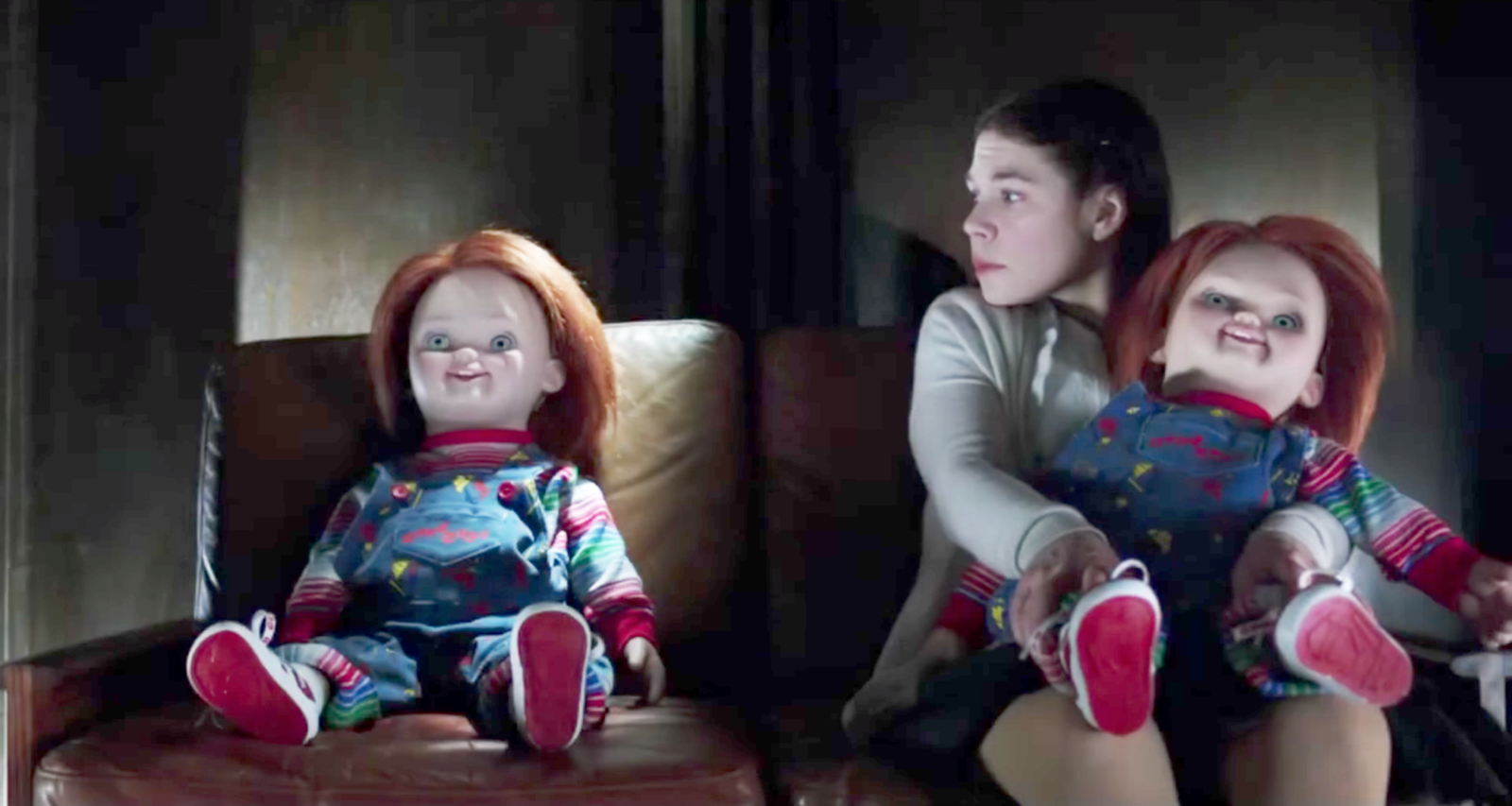
Cult of Chucky, which was released on DVD, Blu-ray, and VOD on Oct. 3, feels both familiar and like its own distinctive film. “I wanted to maintain the legitimately scary vibe that we had from Curse of Chucky, but at the same time, up the comedy quotient a little bit,” Mancini said.
In the sixth sequel to Child’s Play, Nica is now confined to a mental institution after being framed for the murders of her family. As Chucky wreaks havoc on the institution, Nica once again struggles to convince those around her that the doll is alive. Meanwhile, Tiffany (again in human form) is trying to fulfill Chucky’s plans while Andy is doing everything in his power to stop that from happening. If it sounds like there’s a lot going on, that’s because there is — and that’s not to mention the fact that, by the end, there are multiple Chucky dolls spreading chaos.
“The whole vibe of it is completely new: This is a mindfuck movie, and we’ve never done that before,” Mancini said. “This was a movie that I wanted to make the audience feel like they were crazy.”
Reviews for Cult of Chucky have been even more positive than they were for Curse of Chucky: The Hollywood Reporter called the film “part self-spoofing slasher, part lowbrow bloodbath and all guilty pleasure.” At IGN, William Bibbiani wrote, “Cult of Chucky has big ideas, strong performances and some moments that rank among the best in the series. The other classic slasher franchises may be failing, but lately, Chucky is making entertaining horror sequels look like child’s play.”
But Cult does have its share of detractors, particularly fans who are over what they perceive to be the tonal whiplash of the series. The film is nowhere near as wacky as Seed of Chucky, to be clear, but it reflects Mancini dipping his toe back into the camp.
“You can't please everybody anyway, and I would rather do something bold and interesting that's maybe going to alienate some people,” he said. “Particularly now in this era of Annabelle, which is great and a very successful killer doll franchise, it's all the more important for Chucky to hold onto his identity. And part of what makes Chucky distinct is that he's a funny character.”
So does that mean the next sequel, which Mancini already has a plan for, will be another straight comedy? Of course not, he insists. Because that’s what people are expecting now. Chucky works in any context, Mancini repeatedly notes, so the possibilities are endless. The only thing he refuses to do is make anything predictable — and as long as he maintains control over the franchise, which is something he's planning on, there is no end for Chucky in sight.
“The only thing that can kill Chucky is bad box office and so far, in 30 years, that has not happened,” Tilly said. “I hope that Don will be making Chucky movies for the next 30 years, and I hope he puts me in every one of them.”
Dourif noted that he now has a familial link to the series with his daughter Fiona stepping in as the new lead, not to mention the fact that he’s best known — despite his other achievements — as the voice of Chucky.
And Mancini's three-decade-career in horror means he knows you can’t keep a good slasher villain down. His prediction: “The character will outlive us all.” ●
